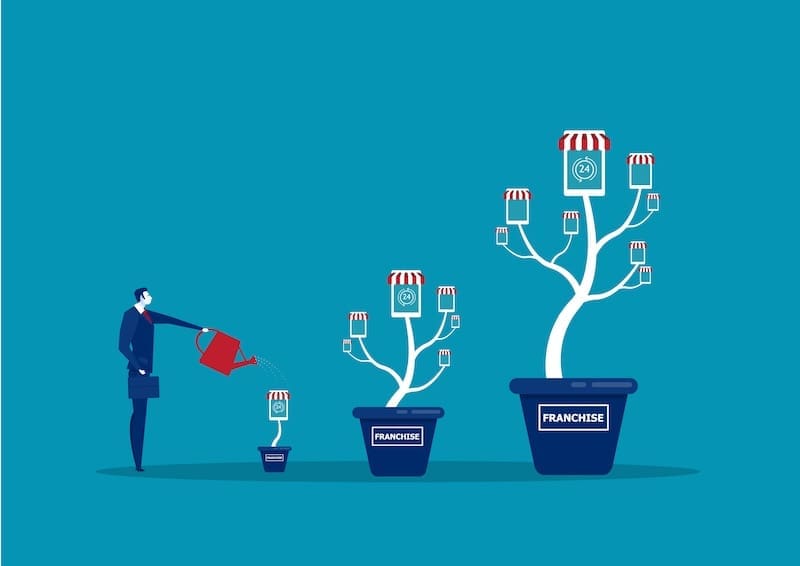
This article about franchise reputation management explains how a single location can impact the entire brand.
In a franchise system, every business location shares the same brand identity. That brand identity stretches from the logo and website to advertising campaigns and customer promises.
Each franchise may be operated by an independent owner, but customers don’t think about that much. Instead, they think of the entire brand as a single entity. That means the public perception of a franchise as a whole comes down to the reputation of the singular franchise or the few franchises a customer frequents.
Local search tools, review platforms, and social media also condense public perception. One customer’s experience at one local franchise can lead to an online review and a viral social media post that then impacts a much broader perception of the entire company, reaching across communities, cities, states and even countries.
In this article, we’ll discuss how franchise reputations are interconnected and how the perception of a single franchise can impact the others. We’ll also discuss how franchise owners can prevent and fix reputational damage.
Do you need help with reputation management for your franchise or corporation? Call us at 844-230-3803 for more information.
Why Is Franchise Reputation Interconnected?

The biggest reason why franchise locations represent the bigger company is because of branding consistency:
- Every location has the same logo, menu, name, services, slogans and uniforms.
- Campaigns across digital media, radio and TV speak of the brand as one cohesive entity.
- Franchises may legally be individual businesses, but they operate under the umbrella of the brand.
- Customers don’t usually know if a location is part of a franchise or owned by the corporation.
- Review platforms may collect all reviews under the company name instead of separating them by franchise location.
- Brands share customer stories on social media from main corporate accounts instead of individual franchise accounts.
That means that if a brand promises fast, polite service, but people experience slow, rude service at their local branch, the reputation of the entire brand suffers. It made a promise to its customers, and the failure of one or multiple franchise locations becomes a failure of the whole brand. Customers assume the entire chain is problematic instead of singling out specific locations.
Review Responses Have a Big Impact
The way one franchise responds to reviews can also feed into the brand’s overall perception. Here’s why:
- Most consumers expect a response to their review within 2 to 3 days and no longer than a week.
- 70% of consumers expect brands to personalize their responses to customer support needs.
- 88% of consumers would use a business that replies to all reviews, both positive and negative. However, only 47% would use a business that doesn’t respond to its reviews.
If a franchise responds poorly or fails to respond at all, they’ll appear unprofessional to customers. If screenshots are taken and shared online, this can spread the bad news around without clarifying that the problem is only with one location.
What Happens if a Franchise Gets a Bad Reputation?

There’s so much fallout that can result from one bad experience or a franchise location that’s notorious for poor quality.
Social Media Accelerates the Negativity
Social platforms favor emotional content, particularly outrage or shock. That means that a video of a rude employee or a messy dining area can quickly go viral. From there, viewers won’t consider that the experience is only at one store of many; they think of it as a problem with the brand overall and judge it accordingly.
Negative Reviews Build Up
If one franchise location regularly gets poor reviews (4 stars or less), that specific business could get more attention and rank higher in search results. From there, both search engines and customers will interpret the feedback as being reflective of the brand. As a result, all of the brand’s franchises could experience a slump in revenue.
How Franchise Reputation Impacts Revenue

Today, so much of customer behavior is dependent on reviews. Consider these stats:
- Over 93% of online shoppers read reviews before buying online.
- As much as 91% of customers say their overall perception of big brands is impacted by reviews of local branches.
- Recent reviews matter most. The “sort by newest” feature on Google reviews is the most useful, according to 47% of consumers.
From there, customers often prioritize the regional franchise location with the best reviews.
For example, many people live close to a few different Starbucks locations. If the one that’s closest to you has a strike against it — maybe the line always moves slow or the floor is often dirty — you may go out of your way to go to a Starbucks location that’s farther away but offers a better experience.
The higher-rated local franchises are the ones that get more foot traffic, and the lower-rated ones lose out on revenue.
When that happens, the overall brand reputation starts to dip, even if there are many locations that still perform well. While the brand may not tank completely, those poorly performing locations will drag down the overall perception of the brand.
From there, the corporation has to spend more money to regain trust through marketing. Here’s how that cuts into revenue:
- Extra money has to go to an ad budget that rebuilds customer confidence.
- Discounts are offered to incentivize more visits.
- Public relations efforts are needed to communicate that the brand is credible.
- The cost of acquiring a customer goes up across the entire brand.
This can have even bigger effects when you consider investors. If an investor is considering buying a franchise location but sees negative coverage in their territory, they may opt for a different brand altogether. This makes it more difficult for brands to grow and expand into fresh markets.
Give us a call at 844-230-3803 to learn more about how we can help with franchise reputation management.
Early Warning Signs for Corporations To Pay Attention To
There are a number of red flags that could mean a franchise’s reputation is slipping. Here’s what corporations should watch out for to save the brand’s reputation:
Digital Symptoms
- Location’s rating goes down by up to half a star over one quarter
- Negative sentiment revolves around specific issues
- Reviews are responded to slowly or not at all
Operational Symptoms
- Communication breaks down between the franchise and corporate support
- Customer complaints mention the same issue
- There’s a sudden high amount of staff turnover
There may also be a cultural symptom to watch out for if franchisees become financially strained, overwhelmed or understaffed.
Today, online reputation management is more important than ever before. Get started with a free analysis here or explore our services.
How Brands Can Prevent Franchise Reputation Risks

There are several ways that brands can ward off independent franchises from getting a bad reputation.
Automated Review Requests
After a customer makes a purchase, they should automatically get a request to leave a review. CRM triggers can send email or text requests for feedback, for example. It’s also smart to include a QR code to a review platform at the bottom of every receipt.
Standardized Review Response Guidelines
Brands can provide franchisees with review response scripts. Whether the issue is cleanliness, policy confusion, pricing complaints, slow service or staff behavior, every franchisee will know exactly how to handle it to be aligned with the brand.
Review responses should acknowledge the issue, show empathy for the customer’s experience, and go offline to offer a resolution. Most importantly, franchisees and employees should never argue with customers or be unprofessional when responding to feedback.
Centralized Reputation Monitoring
Corporate dashboards should display reputational information, such as:
- Average review score by location
- Monthly changes to ratings
- Flags when sentiment drops suddenly
Additionally, the umbrella corporation should offer quarterly training to franchisees and staff to reiterate behavior expectations, scripts and standards.
How To Repair Franchise Reputation Damage
You won’t be able to prevent every problem from occurring. When reputation repair is required, here’s what to do:
Publicly Acknowledge the Problem
Don’t blame the customer, and don’t hide behind policy-speak. Instead, validate the customers who’ve had the issue, apologize for the experience and commit to making it better. Then, take the conversation offline to deal with specific instances privately until they’re resolved.
Fix Internal Issues
Decide which internal systems need to be improved, such as:
- Auditing cleanliness, wait times, etc.
- Replacing management
- Retraining staff
Prioritize what will make the biggest difference and work on that first.
Reintroduce the Location to the Community
Show the community that things are different now by:
- Launching an “under new management” campaign
- Partnering with charities, community events and schools
- Creating “meet the team” content on social platforms
The point is to show that while the brand name stayed the same, the franchise location has had an overhaul for the better.
Rebuild Your Review Profile
It’ll take time for reviews and ratings to be beneficial to your business again. A review management strategy should include:
- Encouraging happy customers to leave honest reviews
- Avoiding incentives that might violate review platform guidelines
- Being patient — it could take 6 weeks to 3 months to see an improvement
Reviews make a huge difference when it comes to franchise success. Staying the course and giving it time are necessary for a positive outcome.
Wrapping Up
Individual franchises don’t have singular reputations. What happens to one franchise impacts the rest of the locations in your area, state or beyond.
Strong brands consider the reputations of single locations to be shared. Every single brick-and-mortar store contributes to the overall value — or lack thereof.
Long-term success for the corporation and the single franchises comes from proactive training for managers and employees; consistent monitoring; quick intervention; and trust throughout the community.
OnlineReputation.com provides information and services to help you protect your digital presence. Get started with a free online reputation analysis here and learn about our franchise management services here.
You might also like
What Is a DMCA Takedown? Everything You Need To Know
This article about franchise reputation management explains how a single location can impact the entire brand. In a franchise system, …

